|
Ritz / ABC / Cannon Cinema Broadway / Leeds Road, Bradford.
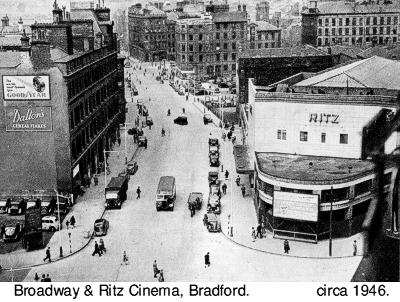
Location ABC Pre-history Maxwell (1876-1940) a former Glasgow solicitor had also taken controlling interest in the Pathé distribution company and he established Elstree Studios. In the 1930s Bradford was a growing, busy and very prosperous city and already had one of the largest and most elaborate cinema/theatre complex outside London - the luxurious 3,500 seater New Victoria complete with ballroom, restaurant and tearoom/cafe and was the entertainment showpiece of the city and, indeed, of the north of England. A business rival, Oscar Deutsch of Odeon Cinemas Ltd, also thought Bradford was the place to be and in 1938 built his new Odeon Theatre super-cinema with 2,713 seats (larger than his flagship Odeon in Leicester Square) and with many luxury features to offer a high level of comfort. Maxwell's ABC circuit had acquired a prominent city-centre site for their proposed new Ritz super-cinema but realised that in order to compete with the New Victoria (of 1930) and brand new Odeon (of 1938) then ABC had to come up with something rather special and utilized a William Glen design to maximize use of the important triangular corner site. The ABC controlled Savoy had already closed in April 1939 and the licence transferred to the planned new Ritz. The Building ABC's John Maxwell was credited with the idea to incorporate several self-contained shop units next to his cinema entrances to provide revenue from their rental - the idea was also taken on board by the rival Odeon circuit. Maxwell's shops idea was on a much larger scale on this Bradford project than elsewhere simply due to the triangular site and rounded apex corner. The exterior was of red brick with cream terracotta faience which not only looked elegant but stood out among the surrounding soot-blackened Victorian stone buildings of that part of the city. Contractors Interior The foyer extended the full width of the auditorium rear and provided a central entrance to the stalls down wide steps to an inner foyer. The stalls steps were flanked on each side by pay boxes then staircases leading up to the circle via a wide curved balcony overhanging the stalls entrance then leading to the circle inner foyer with its toilets and managers office. The idea of these inner foyers was to provide a lower level of lighting and a heat/draught/noise trap before entering or leaving the auditorium so adding to patron comfort. On the extreme outer side of the foyer circle staircases were huge pillars to accentuate the grandeur of the entrance foyer. Large pendant light fittings dominated the high ceiling. The staircases and inner lobbies were thickly carpeted and the entrance foyer floor rubber tiled. Decoration was in warm and welcoming tints. Auditorium The circle was entered via a central vomitory to the cross-over aisle separating front and rear circle with seating in three blocks with two centre aisles and side aisles stepped and with excellent sightlines. The sweeping curve of the circle emphasised its width and with 'slips' leading to exit stairs behind the splay walls. The ceiling was typical Glen with scalloped plaster edging at ceiling steps and large roses with circular scalloped edges for the elaborate pendant light fittings. The side walls had horizontal dark bands to emphasize length. The curved and distinctive splay walls were a special feature with prominent decorative grilles for ventilation and organ chamber along with vertical cove lighting effects. The proscenium opening at 38 feet was fronted by a curved orchestra pit with its frontage topped by a fresh floral display. The pit housed the 3-manual Compton organ on an electric lift able to rise to stage level. The pipe chambers were housed in the right-hand splay wall whilst the organ console was positioned to the left side of the pit. Click for more details of the Ritz Compton organ and its organists. The stage was 15 feet deep with two dressing rooms. The stage itself was heavily dressed with two sets of tabs from the front house tabs back to screen tabs via two matching legs and three sets of stepped festoon borders with coloured lighting battens in between and traditional footlights. The screen was masked with square corners in contrast to the rounded corners still in use at some other older picture houses. The Ardent deaf aid system was fitted and the first in a Bradford cinema. Projection Room Civic Opening It was not usual for Maxwell to attend his openings and usually preferred minimum formality then get on with entertaining paying customers. However, Bradford did enjoy a spectacular gala opening befitting its latest super-cinema. Arthur S. Moss, general manager of ABC (and previously a controller for GB and PCT Kinema and Moss Empires) presided at the opening saying that he was "pleased to see so many magistrates and municipal officials and a truly representative gathering of Bradford". Moss also said he was "pleased to say that the majority of workmen employed on this job came from Bradford". The Telegraph & Argus reported Moss's invitation to the audience "Come whenever you like - though there would, of course, be just a slight formality at the paybox" (laughter from the non-paying invited guests). Also on stage for the opening was the Lady Mayoress (Mrs Robinson), the Deputy Lord Mayor (Mr Henry J. White and Mrs White), Mr and Mrs G. Howick and Mr L. Durban-Long, the manager who was always to be seen in his white tie and tails. The evening programme comprised . . . The gala evening concluded with the civic guests enjoying a reception and dance at the nearby Midland Hotel then the city's top class hotel. Three Super-cinemas Compete Now with three city-centre truly luxurious super-cinemas - something other Yorkshire towns could only dream of - the competition was really hotting up. The sumptuous and huge New Victoria promptly reduced its Balcony prices to 6d and 9d for weekday and afternoon performances. The large luxurious Odeon said confidently "it did not feel the need to change"! The smaller Tatler fought back with "Still the cosiest cinema in Bradford, with bargain matinées 4d and 6d". The old Empire adverts proclaimed "Usual cheap Matinée prices until 4.00pm". The War Years Like all cinemas, the Ritz enjoyed boom times during the war and did not suffer any damage in the air raids on Bradford. The Compton organ was a popular feature where Norman Briggs played during the early part of the war before becoming resident organist at the New Victoria. ABC Minors Club ABC Minors had their own song to the tune of 'Blaze Away' by Abe Holzman (1874-1939) with the words projected on screen from 3.1/4inch square glass slides as seen in the photograph. 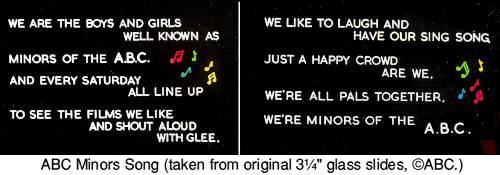 1946 Flood Damage The Ritz entrance foyer was at pavement level without any step and the auditorium stalls well below street level. The front stalls, orchestra pit and understage area was flooded as water gushed in. The Compton organ at its lowest level on the lift could not be raised in time and so was destroyed by the floodwater. Cinders and wooden setts from the roads were washed into the cinema. All the carpets and some seating was damaged. The assistant manager, W. Barraclough, initially could not say when it would be possible to re-open but it did manage to open on Wednesday 25th September 1946 with patrons seated only in the circle for a few days; the seating capacity after clean-up became slightly lower at 2,021.
On-Screen Advertising Supporting FeatureThe Pearl & Dean story still lives on six decades later and its famous intro music can be found on the internet. Adult-only Films 'A Streetcar Named Desire' (Warner 1951, brutal rape).All of which proved very popular at a time when audiences were flagging and many more X-films were to follow. Managers Widescreen and 3-D The Ritz was the only city-centre cinema to install 3-D and films shown included . . . CinemaScope The new system opened on Monday 18th October 1954 with the first CinemaScope musical - the wide medium being exploited here by Warner Brothers. Although initially impressive on the 35 feet wide screen fronted only by house tabs, the image appeared distorted at the extreme sides. Stereo sound later appeared with the MGM 'Perspecta' system using three speakers behind the screen. The ambient system (as promoted by Fox) using auditorium speakers was never fitted. The Peerless arcs installed in 1953 were increased in power. Earth Tremor then more Floods 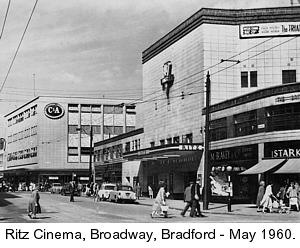
In the mid 1960s the ageing Western Electric set was replaced by the RCA sound set. Auditorium and foyer pendant light fitting were replaced by the more modern 'spray' fittings. The 1960s also saw the development of new shops and offices along Broadway. Significant here were the larger shops built around the ABC and the creation of inner and outer sets of doors as the entrances had been moved further outwards with the result that the cinema was much warmer and heating bills reduced. On Tuesday 2nd July 1968 following a freak storm, the city centre was again flooded with water flowing at a reported five knots along Broadway towards Forster Square and flooding into the ABC foyer (just as in 1946) and down into the front stalls. Although little damage was done, it did need a major clean-up. EMI take control In 1971 EMI Cinemas and Leisure through its Minors Promotions Department publicised heavily the ABC Minors club and its films supplied by the Children's Film Foundation - a non-profit-making organisation sponsored by the British film industry and the only one of its kind in the world. Closure as a Single Screen "Remember Me This Way" - 1974 UK Eastmancolor 57mins. Conversion to Triple The newly created ABC1 utilised the former circle and 'Scope screen in the original proscenium opening. The two smaller auditoria had new screens with tabs and projection rooms built complete with their own independent heating and ventilation and soundproof cladding.. The previously large and lofty entrance foyer was divided into two with the larger part forming the cinema entrance from Broadway whilst the smaller part adjacent to Leeds Road was turned into The Painted Wagon Saloon to be a trendy pub/bar open to non-cinemagoers. The redecoration of the new triple was colourful to say the least. The Broadway foyer had orange walls and gold carpet whilst the main ABC1 with 732 seats was mainly red. ABC2 with 184 red seats and French blue walls and carpet. ABC3 with 166 seats in orange, royal blue walls contrasting with red carpets and drapes. The total capacity was now 1082, a little over half of the original. EMI-ABC Film Centre Opens ABC1 opened Sunday 6th October 1974 with . . . "Blazing Saddles" - 1974 USA Technicolor 'scope 93mins.Opening on Monday 18th November 1974 was . . . ABC2Two weeks later was the Grand Free Re-opening of the Minors' Matinée on Saturday 30th November 1974 at 10.00am in ABC1. Childrens' matinées then continued every Saturday morning with admission only 10 pence. The manager was now Peter McRae with William Adland as chief projectionist. Projection equipment now used the large capacity 'cake stand' film platter requiring less staff on duty. Promotional Stunts In early September 1979 patrons were greeted with the sight of a coffin in the foyer as the latest 'Dracula' film started its run in ABC1. Ken Lamb had a flair for publicity which had won him awards in the past - so continuing the early concept that managers should also be showmen. He was later joined by Stephen Prothero then Christine Schofield as assistant managers. In 1979 EMI merged with Thorn Electrical Industries and became Thorn EMI adopting the Thorn logo of an upright thorn - a name already well known in Bradford due to the presence of the company's television (Baird/Thorn) manufacturing. By 1983 the name had changed to Thorn EMI Screen Entertainment (TESE) - despite all these changes the cinema still remained EMI-ABC although many older people still referred to as the Ritz. In late 1983 in expectation of a resurgence of 3-D films, ABC 2 was upgraded with its projector uprated to a higher output Xenon lamp and the screen replaced by one of higher luminance. The film was the much hyped . . . The third dimension is terror!The film was not for the faint hearted and was not the success it was hoped for with Bradford audiences. Cannon Take Control EMI-ABC cinemas in a deal worth £175million were taken over by Cannon in 1986 and renamed Cannon on 10th February 1987 whereupon Cannon immediately introduced a 'No Smoking' policy to begin on Wednesday 4th March 1987 which, believe it or not, was Ash Wednesday! However the Cannon triple was not doing good business and closure was rumoured. Final Closure The closing films in ABC2 and ABC3 were . . . ABC2 "Hell Raiser" - 1987 UK Technicolor 94mins.The closing film in ABC1 was the local premier of . . . "Rita, Sue and Bob Too" - 1987 UK Eastmancolor 95 mins. 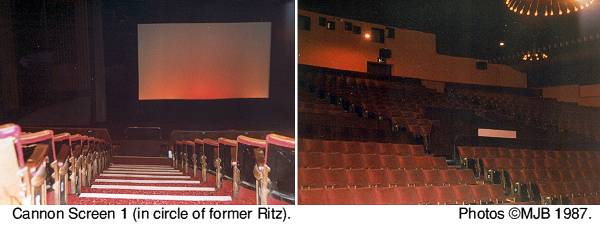
Rita, Sue and Bob Too was a good film on which to end - based on the play by Bradford playwright Andrea Dunbar and filmed around Bradford and Baildon. Queues had formed in the early evening rain and the auditorium soon filled with mainly new students from the nearby college and university and whose lively chatter created an atmosphere as there was no background music and no house tabs, only the bare screen as the tabs and border had been removed earlier. The decorative cove lighting in the splay walls which had long been a distinctive feature was not functioning. The cinema had all the feeling of being on its last breath of life. 
Fortunately the film was both saucy and hilarious especially to people who knew Bradford and recognised the locations and maybe even identified with some of the characters. As the credits rolled the audience filed out - most to the nearest pub, all the display posters and sales kiosk stock had been removed and it really was a case of 'last person out switch off the lights'. The following days saw the removal of equipment and the cinema boarded up. Demolition May not be copied or reproduced without permission.
|
 John Maxwell's growing ABC (Associated British Cinemas) circuit had a presence in Bradford since the late 1920s when the
John Maxwell's growing ABC (Associated British Cinemas) circuit had a presence in Bradford since the late 1920s when the 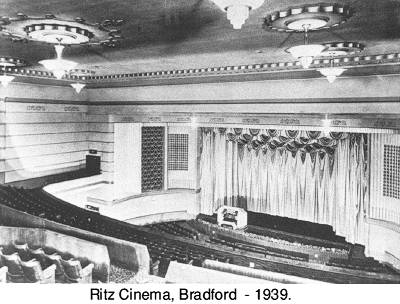 The Ritz auditorium was splendidly proportioned and a true classic of Glen design with 2,037 seats in a sumptuous visual setting. The fan-shaped stalls with raked floor was below ground level with theatre-style seating arranged in three blocks with two centre aisles and side aisles and a cross-over aisle.
The Ritz auditorium was splendidly proportioned and a true classic of Glen design with 2,037 seats in a sumptuous visual setting. The fan-shaped stalls with raked floor was below ground level with theatre-style seating arranged in three blocks with two centre aisles and side aisles and a cross-over aisle.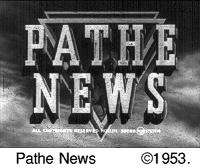
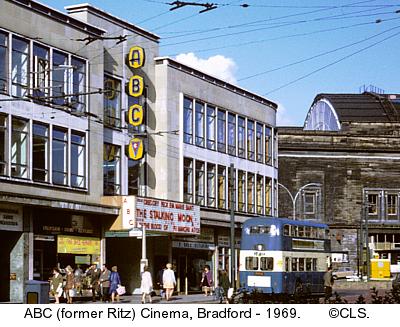 On 27th February 1969 EMI had taken control of ABPC (Associated British Picture Corporation) and the company renamed EMI Film and Theatre Corporation now headed by Bernard Delfont. The Ritz continued to be known simply as the ABC but carrying the EMI logo. By February 1970 the Pathé News, once the UK's leading newsreel had ceased and unable to compete with the immediacy of television news.
On 27th February 1969 EMI had taken control of ABPC (Associated British Picture Corporation) and the company renamed EMI Film and Theatre Corporation now headed by Bernard Delfont. The Ritz continued to be known simply as the ABC but carrying the EMI logo. By February 1970 the Pathé News, once the UK's leading newsreel had ceased and unable to compete with the immediacy of television news. Following the arrival of Ken Lamb as manager with his penchant for promotional stunts which attracted press publicity and hopefully more patrons. In October 1978 it was a case of "Howdy Pardner" as 'The Wild Bunch' will be keeping things in order and if anything gets out of hand there is likely to be a shoot out" - his novel innovation to get more children interested in the cinema and visit its ABC Minors on a Saturday morning.
Following the arrival of Ken Lamb as manager with his penchant for promotional stunts which attracted press publicity and hopefully more patrons. In October 1978 it was a case of "Howdy Pardner" as 'The Wild Bunch' will be keeping things in order and if anything gets out of hand there is likely to be a shoot out" - his novel innovation to get more children interested in the cinema and visit its ABC Minors on a Saturday morning.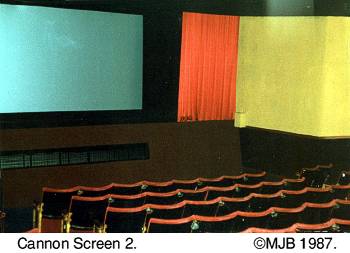 A new name was to hit Bradford, it was the then fastest growing UK cinema circuit - the Cannon Group - whose acquisitions included Classic, Star and now ABC and Granada circuits and formed by Israeli cousins Menahem Golan and Yoram Globus with an interest in film making as well as exhibiting.
A new name was to hit Bradford, it was the then fastest growing UK cinema circuit - the Cannon Group - whose acquisitions included Classic, Star and now ABC and Granada circuits and formed by Israeli cousins Menahem Golan and Yoram Globus with an interest in film making as well as exhibiting.